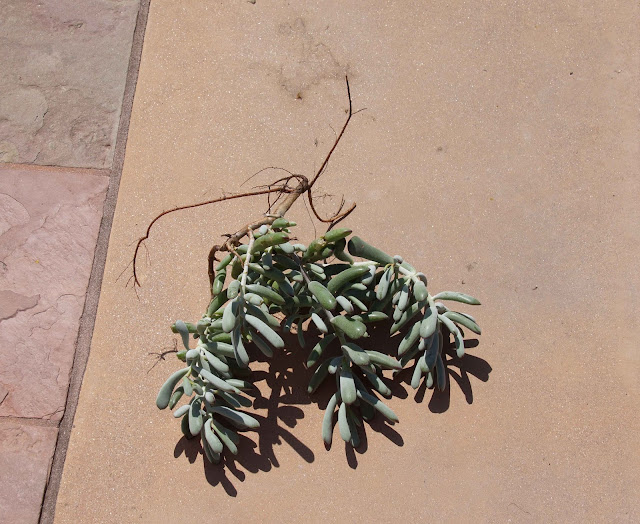Above, New plantlets sprouted from a bloomed-out stem in February.
Back in late February, I wondered if the plantlets sprouting from the base of leaves on a bloomed-out Kalanchoe luciae would take root.
The plantlets took their time. It has been almost two months of waiting and checking and waiting again. I placed some of the plantlets in loose, damp soil, others in loose, damp potting mix, both groups in well-shaded locations.
Roots! Finally!
More Kalanchoe luciaes! Yay! There are also some offsets of the original, so no K. luciae shortage here this spring.
Kalanchoe beharensis propagation is a little different. It requires only a leaf laid upon damp-ish, loose soil in a shaded location. This species is also very slow to take root and grow.
I see four new plants! This leaf fell from the original plant several months ago. I moved the leaf to a spot of bare soil where it could develop new plantlets. In contact with the bare soil, the plantlets could then grow roots.
This next photo shows a new plant from a leaf dropped to the ground two years ago. They are not fast, but the price was only patience, and the effort required near zero. In my garden this species seems happiest with morning sun and afternoon shade (luciae does as well). Potted, in full sun it holds very few leaves--with more shade it retains more foliage. It would undoubtedly be happier in the ground--I'll have to look for a spot.
Another slow growing member of Crassulaceae is Cotyledon hybrid(?) 'Happy Dancing Girl', which grew on the front slope for several years. I had two clumps of it. The first died in 2012 after a bloom. After a spectacular bloom in 2013, the remaining plant also suddenly died, for reasons unknown. Do they die after bloom? Unknown. Maybe?
When I pulled the second dead plant out in 2013; there was a small bit of stem partially alive, which I threw under the Calothamnus villosus. The bit of stem managed to grow in the dry shade to the point where I thought I'd replant it in a visible spot on the slope again, this time with the silvery Agaves like A. 'Ivory Curls' and A. titanota.
Dug up, the lack of root system was quite a surprise. This is the entire root system!
Well that was easy to dig out:
Here it is replanted--I wonder if it will grow more roots. If it survives I'll move the tiny Agave utahensis barely visible to its left before the Agave is overwhelmed. Maybe I should move the Agave anyway--it is struggling. Too small to have left the pot.
The Cotyledon foliage has the same silvery color as Agave titanota, with a different texture:
Okay, that's the Kalanchoe update.
I've started a new project, a rehab of a temporarily abandoned part of the garden. But that's a subject for another post.







While some succulents seem so easy to propagate, other do show us why those plants often cost as much as they do. I just planted a couple of pieces from a bloomed-out noID Kalanchoe myself but I was much less thoughtful about it and will probably be less successful.
ReplyDeleteYes, and the time they take, slow=expensive. All my K. luciae come from 1 original plant that I treated horribly (no water for literally years), and yet it gave me a bunch of offsets in the end. You might end up with way more than you ever want!
DeleteIt is amazing how some plants can survive with little attention, yet others like my Echeveria Paludonis? which cost quite a lot died very quickly,though I think I may have watered it too much. There seems to be a fine balance between care and neglect with some succulents, my Kalanchoes look great when I first buy them, covered in flowers but after a few months their foliage doesn't look as fresh, yet I will get more flowers.
ReplyDeletexoxoxo ♡
I have discovered some of the Echeveria species are very touchy. The hybrids tend to be easier. Sometimes it is the grower's fault--here they sell them in pure peat, much too moisture retentive once out of the grower's controlled environment.
Delete